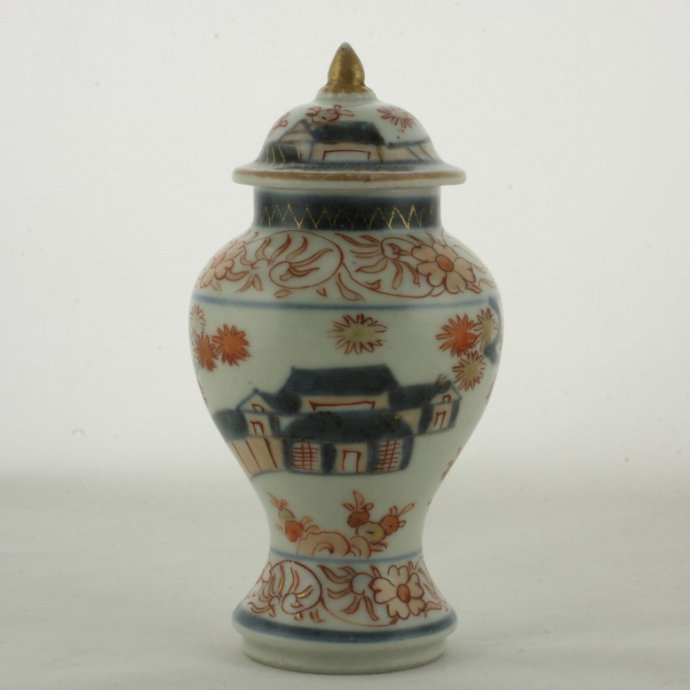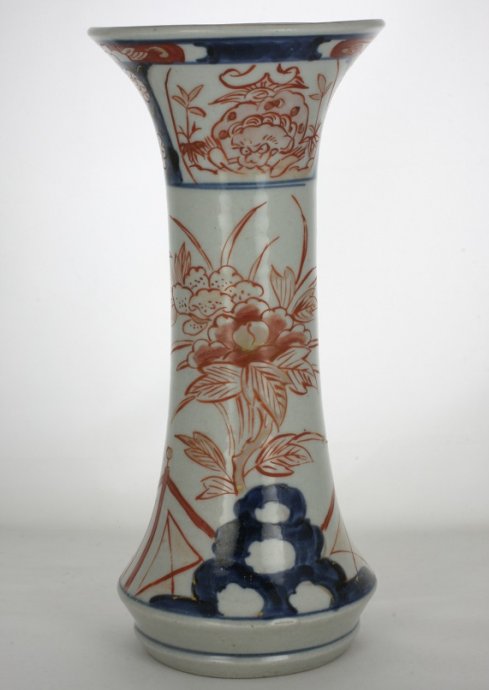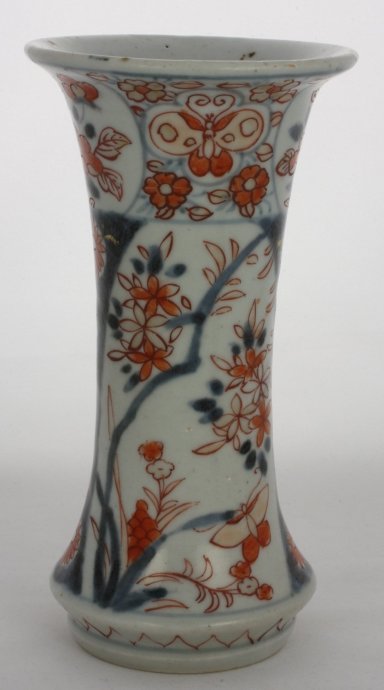Sold Ceramics
Sold Japanese Garnitures or Parts of a Garniture
Page 1

Sold Ceramics - Sold Japanese Garnitures or Parts of a Garniture - Page 1
Object 2011821
Jar
Japan
1690-1720
Height 489 mm (12.40 inch), diameter of rim 179 mm (5.16 inch), diameter of footring 185 mm (4.52 inch), weight 10,900 grams (384.49 ounce (oz.)),
Large ovoid jar on footring, recessed base. Wide upright neck. The original cover is missing. Imari decorated in underglaze blue, iron-red, gold and enamels with three large panels of peony, chrysanthemum, prunus and peach. The shoulders with a band of kidney-shaped panels of similar flowers below two registers of running foliage on the collar and neck. The slightly ridged foot encircled by classic scroll below a basic frieze of leaves and fronds.
This covered jar might have originally been part of garniture consisting of three covered oviform-shaped jars and two cylindrical beaker vases with spreading mouths. They were very popular in the Netherlands and elsewhere in Europe where they were used as decorative items in the interior. Large garnitures could only be afforded by the nobility and well to do who displayed them in the representative rooms and galleries of their palaces and country houses. They were often placed on specially made pedestals or were mounted and functioned as exotic eyecatchers. Placed inside the fireplace they hid the blackened wall from view in summer and filled with sand, these jars were used as extinguishers near fire-places. The origin of the five-piece set has not been established yet but it seems logical to look to China, which influenced Japanese export wares in so many ways. Transitional pieces, including large, covered jars with an enamelled decoration, reached The Netherlands in the 1640s, and clearly had a decorative function in the Dutch Interior. When Chinese production waned, the Japanese took over and from the late 17th century started to make similar jars and beakers in underglaze blue to order for the Dutch. Then, suddenly, they were no longer single objects but parts of five-piece sets. Large scale porcelain production for export was resumed in China in the early 1680s and many new shapes emerged. Apparently, the garniture set was among them. What exactly triggered the change from the single vase or beaker to a set is not known. Japanese covered jars decorated in underglaze blue usually show Chinese elements such as phoenixes, large flowering plants, rocks, and sometimes figures in a landscape setting. Most jars are globular or oviform. They reflect the relatively rare hexagonal and octagonal Chinese pieces, in particular the Transitional jars of the 1640's. The Chinese had stopped producing polygonal jars in the middle of the 17th century. This Japanese preference for any-sided pieces is also apparent in the shape of dishes, saucers and bowls made for export from the late 17th century onwards. Covers of jars are domed and often quite high. The knobs are large and either flattened, round or pear-shaped and rarely facetted as is the case with this jar It is interesting to note that the decoration on the Arita pieces does not imitate some of the specific Chinese Kangxi patterns, such as the characteristic division in bands of panels but show two or three wide panels filled with motifs taken from nature or a free-flowing composition all over the surface. Complete blue-and-white garnitures are extremely rare nowadays, and most existing single vases or jars might in fact have been part of such a set. When the five-piece sets became popular, the blue-and-white pieces were largely replaced by their polychrome (Imari) counterparts. (Hartog 1990, p.130, cat 158), (Jörg 2003/1, pp.259-260)
These type of large, covered jars may be considered as a form of Japanese 'Chinoiserie' for the European market. In Japan larger covered jars of this kind were called chinkô tsubo (aloe jar), presumably because aromatic substances such as wood were transported in these jars by the Dutch East India Company, (Vereenigde Oost-Indische Compagnie, VOC), from Southeast Asia to Europe. Shards of this type have been excavated on the site of the Dutch trading post of the VOC. in Nagasaki which are dated 1670-1700. (Ströber 2001, pp.156-157, cat. 69)
For identically shaped, sized, and decorated large jars, please see:
- The Wrestling Boys. Chinese and Japanese Ceramics from the 16th to the 18th Century in the Collection at Burghley House, (The Trustees of Burghley House, Stamford 1981), p.47, cat. 121.
- Mistrovská dĩla Japonského porcelánu / Masterpieces of Japanese Porcelain, (F. Suchomel, Prague 1997), p.121, cat. 138.
- Complete Catalogue of the Shibata Collection, (The Kyushu Ceramic Museum, Kyushu 2003), p.323, cat. 2528.
For an identically shaped, sized, and decorated large jar in the collection of Augustus the Strong in Dresden (registered under the number P.O. (Porzellan Ostasien) 9086), please see;
Condition: A firing flaw to the foot.
References:
SKD Online collection, PO. 9086
Price: Sold.

Sold Ceramics - Sold Japanese Garnitures or Parts of a Garniture - Page 1
Object 2010932
Small oviform covered jar
Japan
1700-1720
Height 120 mm (4.72 inch), diameter 62 mm (2.44 inch), diameter of mouthrim 32 mm (1.26 inch), diameter of footring 38 mm (1.50 inch), weight with cover 161 grams (5.68 ounce (oz.)), weight cover 23 grams (0.81 ounce (oz.))
Small oviform jar on footring, wide upright neck. Domed cover with pointed knob on a domed base. Imari decorated in underglaze blue, iron-red and gold. Around the foot and shoulder decorated with a continuous foliate scroll, on the body a, highly unusual, decoration of a temple complex within walls. Around the neck a pointed leaves pattern border in gold. On the domed cover a pointed leaves-pattern border in gold and a temple complex within walls. The base of the gold pointed knob is modelled after chrysanthemum. On the base a rectangular paper collectors label that reads: '5'.
This small oviform jar with cover was once part of a garniture which mostly consisted of three covered oviform-shaped jars and two cylindrical beaker vases with spreading mouths, all with the same decoration, They were very popular in The Netherlands and elsewhere in Europe, where they were used as decorative items in the interior. (Jörg 2003/1, p.259)
Condition: A firing flaw and a frit to the rim of the cover and a chip with two frits to the inner rim of the cover.
Reference:
Price: Sold.

Sold Ceramics - Sold Japanese Garnitures or Parts of a Garniture - Page 1
Object 2010364
Small oviform covered jar
Japan
1700-1730
Height 123 mm (4.84 inch), diameter 62 mm (2.44 inch), diameter of mouthrim 35 mm (1.38 inch). diameter of footring 41 mm (1.61 inch)
Small oviform jar on footring, wide upright neck. Domed cover with pointed knob on a domed base. Imari decorated in underglaze blue, iron-red and gold with around the foot and shoulder a flowering prunus scroll border. In between both borders flowering peony, chrysanthemum and poppy plants and three hõ-õ birds in flight. On the upright neck and the rim of the cover a spiral pattern border. On the domed cover flowering peony and chrysanthemum plants. The base of the gold pointed knob is modelled after chrysanthemum.
Porcelain miniatures were popular in The Netherlands, where they were used to furnish doll's houses, which were not children's playthings but professionally furnished replicas of townhouses. In general, miniatures were included in groups of decorative porcelain placed on shelves, brackets and consoles in the Dutch interior, or in the porcelain rooms of the grand houses, such as those still in Pommersfelden and Charlottenburg. Germany. (Jörg 2003/1, p.190)
Condition: A small hairline to the rim and fine crazing to the glaze.
Reference:
Jörg 2003/1, cat. 191, 193 & 238
Price: Sold.

Sold Ceramics - Sold Japanese Garnitures or Parts of a Garniture - Page 1
Object 2010438
Beaker vase
Japan
1720-1750
Height 350 mm (13.78 inch), diameter of mouthrim 115 mm (4.53 inch), diameter of waist 63 mm (2.48 inch), diameter of footring 80 mm (3.15 inch)
Beaker vase of waisted cylindrical shape on footring, flaring rim and spreading lower part tapering to a takefushi-shaped foot. Imari decorated in underglaze blue, iron-red and gold with two groups of pierced rockwork with a fence and flowering peony plants. Around the mouthrim, two panels, filled with a shishi (Buddhist lion), a Japanese variant of the Chinese shi-tzu (Dog of Fo) standing in between foliage. The inside is undecorated.
The "Chinese lion" or kara shishi is supposed to be the Chinese conception of a creature never seen in China but told of by travellers or copied from the pictures from India as there are no records of lions in ancient Chinese writings before about 250 A.D. It is also called a Chinese Dog or Dog of Fo (Buddha) from which it is clear that dog-like characteristics prevail over the original leonine ones. The lion symbolizes guardianship and protection, from which belief is derived the practice of placing statues of lions at the doors of palaces and tombs as guardians of both the living and the dead against all evil. (Fitski 2011, p.160)
The shishi is characterized by a fierce expression, large bulging eyes and curly mane, a bushy tail and curly locks of hair on the legs. Japanese pairs of figures of shishi usually have both animals with an ornamental / brocade ball, whereas Chinese examples usually have one with a ball, the other (female) with a cub. It is clear that the shishi is no ordinary lion, but a mythical beast. It is probable that the lion in this mythical form came over from the Middle East as a guardian figure in Chinese pre-historical times. After the introduction of Buddhism, the shishi retained its function as a guardian, and pairs of these animals were placed on either side of the entrance of temples in China and Japan. (Arts 1983, p.110)
The shape of the bulging foot, which spreads and then turns sharply inward, is seen on many ewers of this period as well as on later jars, vases and other pieces. It is a distinctively Japanese feature, called takefushi, 'bamboo-noded' foot. (Jörg 2003/1, p.74)
Condition: Perfect.
References:
Price: Sold.

Sold Ceramics - Sold Japanese Garnitures or Parts of a Garniture - Page 1
Object 2010439
Beaker vase
Japan
1720-1750
Height 164 mm (6.46 inch), diameter of mouthrim 89 mm (3.50 inch), diameter of waist 55 mm (2.17 inch), diameter of footring 57 mm (2.24 inch)
Beaker vase of waisted cylindrical shape on footring, flaring rim and spreading lower part tapering to a takefushi-shaped foot. Imari decorated in underglaze blue, iron-red and gold with two large shaped panels, each filled with flowering plants and a flying butterfly reserved on a dark blue ground that has chrysanthemums outlined in red and foliage in gold. Round the mouthrim, four panels, two filled with a flowering chrysanthemum the other two with a single butterfly surrounded by four flowering branches. The inside is undecorated.
This beaker vase was once part of a garniture which mostly consisted of three covered oviform-shaped jars and two cylindrical beaker vases with spreading mouths, all with the same decoration, They were very popular in The Netherlands and elsewhere in Europe, where they were used as decorative items in the interior. (Jörg 2003/1, p.259)
In Japanese ceramic art the butterfly, chõ-chõ in Japanese, is associated with the peony flower and the Chinese lion. In Japan the white butterfly is considered to be the soul of the living or the dead. It is always treated kindly when discovered in the house for it may be a friend come to announce his death. Many legends exist about this belief. A famous one is that of an old man who was lying dying in his room when a white butterfly fluttered in. An attendant tried to drive it out to prevent it from waking the sleeper, after which the insect, followed by the attendant, flew directly to the nearby cemetery, where it lingered on a woman's tomb. After the old man had died it was discovered that the name inscribed on the tomb was that of the old man's fiancée, who had died on the eve of the wedding long ago. The old man had never married, but stayed true to her and visited her grave every day. When he became ill and could no longer go to her, she came to him in the form of a white butterfly. (Arts 1983, p.124), (Gorham 1971, p.200)
The shape of the bulging foot, which spreads and then turns sharply inward, is seen on many ewers of this period as well as on later jars, vases and other pieces. It is a distinctively Japanese feature, called takefushi, 'bamboo-noded' foot. (Jörg 2003/1, p.74)
Condition: A shallow glaze chip to the footring.
References:
Price: Sold.


 create websites
create websites